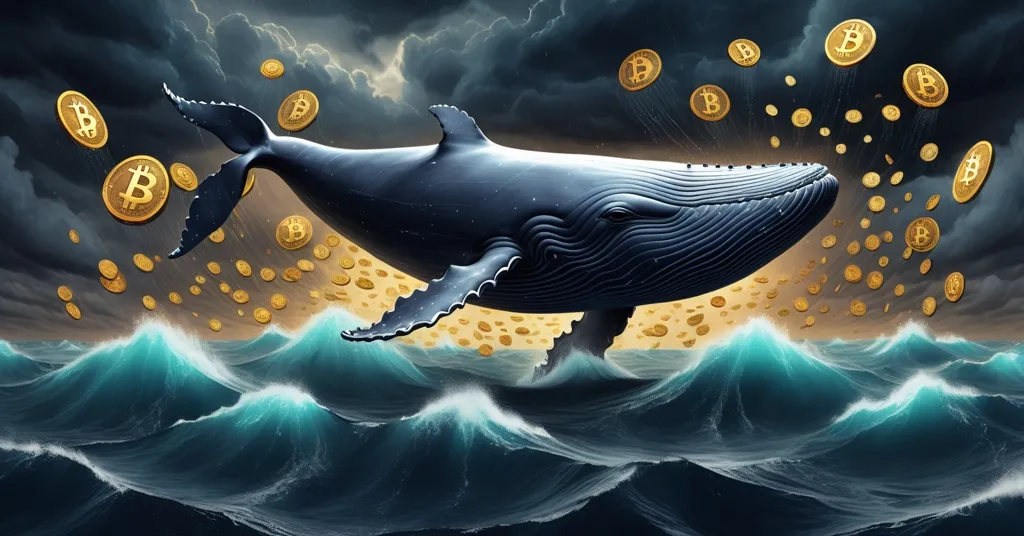Bitcoin Whales Transfer $1.8B to Exchanges, Sparking Market Volatility Fears

Bitcoin Whales Shake Market Confidence with $1.8B in BTC Transfers to Exchanges
Bitcoin’s surge to a striking range of $108,000–$115,000 has fueled excitement across the crypto sphere, but recent moves by two heavyweight holders are casting a shadow of doubt. Known as BitcoinOG (or 1011short) and Satoshi-era investor Owen Gunden, these so-called “whales”—individuals or entities with massive Bitcoin holdings capable of swaying market dynamics—have transferred nearly $1.8 billion in BTC to exchanges like Kraken. With such enormous sums hitting trading platforms, speculation is rife about profit-taking, bearish positioning, or strategic reshuffling, sending ripples of unease through a market already riding high on optimism and volatility. For more on this developing situation, check out the detailed report on Bitcoin veterans offloading BTC and raising market concerns.
- Staggering Moves: BitcoinOG transferred 13,000 BTC ($1.48 billion) to Kraken since October 1; Owen Gunden moved 3,265 BTC ($364.5 million) since October 21.
- Market Snapshot: Bitcoin hovers near $108,000, consolidating between $110,000–$115,000 after a turbulent October.
- Potential Fallout: Large whale inflows historically correlate with short-term price corrections of 5%–10%, stoking fears of volatility.
Breaking Down the Whale Moves: Who Are These Players?
Let’s dive straight into the details of these transactions and the players behind them. First up is BitcoinOG, a pseudonymous figure whose reputation in crypto circles is nothing short of legendary—or notorious, depending on your perspective. Since October 1, this whale has shifted a mind-boggling 13,000 BTC, valued at $1.48 billion at current prices, to Kraken in a series of calculated deposits. A notable chunk, 500 BTC worth $55 million, landed on November 2, while smaller batches ranging from 70 to 150 BTC have trickled into Hyperliquid, a niche trading platform. BitcoinOG hasn’t limited their activity to Kraken either; transfers to major exchanges like Binance and Coinbase suggest a diversified approach, potentially gearing up for leveraged trades or liquidation. For the uninitiated, leveraged trading means borrowing funds to magnify a position, betting on price movements with high risk and high reward—a strategy where a wrong move can wipe you out faster than you can say “HODL.”
What’s got traders on edge about BitcoinOG isn’t just the scale of these transfers; it’s their track record. This whale has a knack for shorting Bitcoin—essentially borrowing it to sell high, aiming to buy back cheaper for profit—during major market downturns. They reportedly cashed in $197 million by perfectly timing the October 11 crash, a move that’s cemented their status as a market bogeyman. When someone with that kind of history starts parking billions on exchanges as Bitcoin flirts with all-time highs, you can bet retail investors are sweating. Are they sniffing out a downturn? Or simply reorganizing their vast holdings? On-chain data from tools like Lookonchain flags every move, amplifying both curiosity and fear among the masses.
Then there’s Owen Gunden, a name that resonates with Bitcoin’s earliest days. As a Satoshi-era holder—someone who amassed BTC over a decade ago when it was worth pennies or mined for pocket change—Gunden has been sitting on a fortune of over 15,000 BTC, largely untouched until now. Between October 21 and November 3, he stirred from dormancy, transferring 3,265 BTC valued at $364.5 million to Kraken in deliberate batches: 364 BTC on October 22, a hefty 1,448 BTC on October 29, and 483 BTC on November 3. Analytics platforms like Arkham have traced these funds to decade-old wallets, underscoring the gravity of an early adopter possibly cashing in. If Gunden acquired this Bitcoin at, say, $1 per coin, the unrealized gains are enough to make even seasoned hedge fund managers green with envy.
Market Implications: Volatility on the Horizon?
Before we jump to worst-case scenarios, a crucial point: moving Bitcoin to an exchange doesn’t automatically equal a sell-off. These whales might be repositioning for leveraged plays, setting up over-the-counter (OTC) deals—private trades that don’t hit public order books—or even using exchanges as intermediaries to cold storage for safekeeping. But let’s not sugarcoat it; the optics suck. Historically, whale inflows of this magnitude, especially at peak valuations, often signal choppy waters. Market patterns show that such large deposits can lead to short-term price corrections of 5% to 10%, as increased supply on exchanges runs into what’s known as thinned liquidity—basically, not enough buyers at current levels to soak up the volume, which drags prices down fast.
Bitcoin’s current price, hovering around $108,000 and consolidating between $110,000 and $115,000, comes after a wild October marked by leveraged liquidations and macroeconomic uncertainty tied to interest rate expectations. The sentiment is a volatile mix of euphoria—driven by institutional adoption and Bitcoin’s “digital gold” narrative—and paranoia, where every whale transaction is dissected for hidden doom. When a player like BitcoinOG, with a bearish playbook, or Gunden, with symbolic OG weight, makes waves, market jitters aren’t just inevitable; they’re amplified by on-chain transparency. Platforms like Lookonchain and Arkham empower retail traders to track these moves in real-time, but they also fuel knee-jerk fear, uncertainty, and doubt (FUD). Is this transparency a net positive for leveling the playing field, or does it just spark panic? That’s a debate worth having.
Historical Patterns: Lessons from Past Whale Dumps
Bitcoin’s history offers a roadmap of sorts for what might unfold. Whale activity has often been a canary in the coal mine, signaling short-term pain before longer-term gains. Take the 2017 bull run: large sell-offs by early holders triggered corrections of up to 30% in weeks, only for prices to rebound as accumulation resumed. Fast forward to 2021, when whale dumps during the post-$69,000 peak contributed to a 20% drop over a month before institutional buying stabilized the floor. Today’s context differs—Bitcoin’s market cap is larger, adoption broader—but the principle holds: big players wield outsized influence, especially in over-leveraged markets where a single sell order can cascade into mass liquidations.
That said, let’s not over-dramatize. A 5% or 10% dip, if it materializes, is a speed bump, not a crash. Bitcoin has survived Mt. Gox debacles, blanket bans in major economies, and countless whale shenanigans, emerging stronger each time. For every seller, there’s often a buyer waiting in the wings—think hedge funds or ETF managers eyeing entry points. The network’s fundamentals, from soaring hash rate to Lightning Network growth for faster transactions, remain unshaken by these maneuvers. Still, timing matters, and with liquidity tight at these levels, even a small wave from a whale can feel like a tsunami to retail traders overexposed on margin.
Beyond Bitcoin: Ripple Effects on Altcoins and DeFi
While Bitcoin takes center stage, whale activity doesn’t exist in a vacuum. A potential sell-off or correction could redirect capital into altcoins or stablecoins as hedges. Ethereum, with its staking yields and DeFi ecosystem, often sees inflows when Bitcoin wobbles, as investors seek diversified exposure. Stablecoins like USDT or USDC might also absorb funds from those parking cash on the sidelines. This dynamic reinforces the nuanced role altcoins play in the broader crypto landscape—niches Bitcoin isn’t designed to fill, like smart contracts or yield farming. As a Bitcoin maximalist at heart, I’ll always argue BTC is the bedrock of decentralized money, but I can’t deny Ethereum and others offer unique value when market winds shift.
Playing devil’s advocate, could these whale moves be less about Bitcoin’s health and more about exploiting retail fear? BitcoinOG’s history of profitable shorts raises eyebrows—some might even whisper “market manipulation”—but Bitcoin’s open ledger exposes these actions to scrutiny, unlike the opaque backroom deals of traditional finance. Whether that transparency curbs or catalyzes volatility is anyone’s guess, but it’s a stark reminder of crypto’s wild west nature, where big fish swim with impunity while small fry scramble to keep up.
Market Sentiment: Greed vs. Fear in a High-Stakes Game
Right now, Bitcoin’s price range reflects a tug-of-war between greed and fear. On one hand, institutional players like BlackRock, with their spot Bitcoin ETFs, signal long-term confidence, countering potential selling pressure from individuals like BitcoinOG or Gunden. On the other, community buzz—think Reddit threads and X posts—often overreacts to whale transfers, painting doomsday scenarios that rarely fully materialize. The reality likely lies in the messy middle: volatility may spike if these coins hit the market, but Bitcoin’s scarcity (capped at 21 million coins) and censorship-resistant design keep its value proposition intact for those with a longer horizon.
What drives a whale to move $1.48 billion in a month? Is it cold, calculating greed, a hedge against unseen risks, or a 4D chess play retail traders can’t fathom? We may never know, but one thing is clear: whales move markets, while hodlers—those who hold through thick and thin—build the future. Bitcoin’s journey as a middle finger to centralized control doesn’t hinge on a few big transactions, no matter how flashy. Still, if you’re leveraged to the hilt, you might want to keep a close eye on Kraken’s order books. Volatility isn’t just a possibility; it’s practically crypto’s middle name.
Key Questions and Insights on Bitcoin Whale Transfers
- What’s behind these massive Bitcoin transfers to exchanges?
Veteran holders BitcoinOG and Owen Gunden have shifted $1.48 billion and $364.5 million in BTC, respectively, to Kraken and other platforms since October, potentially for profit-taking, leveraged trades, or portfolio rebalancing. - Will these whale moves trigger a Bitcoin price crash near $108,000?
Not guaranteed—such inflows often lead to 5%–10% corrections due to supply pressure, but Bitcoin’s track record shows recoveries driven by sustained demand. - Why are traders spooked by BitcoinOG’s recent activity?
With a history of earning $197 million from shorting during downturns like the October 11 crash, BitcoinOG’s transfers hint at possible bearish bets, unsettling retail investors. - What does Satoshi-era holder Owen Gunden’s activity mean for the market?
As an early adopter with over 15,000 BTC held for a decade, Gunden’s moves suggest cashing in on monumental gains or strategic reshuffling, carrying symbolic weight for the community. - Should Bitcoin investors freak out over these whale transfers?
Not really—volatility is baked into crypto; focus on Bitcoin’s core strengths like decentralization and scarcity, and see potential dips as buying opportunities if your strategy allows.
A final word of caution: crypto markets are a speculative beast, and whale signals are just one piece of a chaotic puzzle. Do your own digging before making moves based on these transfers. Bitcoin’s long-term promise as a bastion of financial freedom stands firm, but short-term turbulence is always on the table. Whether these whales are setting up for a dump or a brilliant pivot, one thing is certain: the ride’s about to get bumpy. Stay sharp, stack sats, and don’t let FUD—or FOMO—steer your ship off course.



